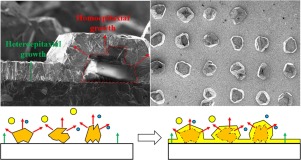当前位置:
X-MOL 学术
›
J. Mater. Process. Tech.
›
论文详情
Our official English website, www.x-mol.net, welcomes your
feedback! (Note: you will need to create a separate account there.)
Fabrication and Evaluation of Monolayer Diamond Grinding Tools by Hot Filament Chemical Vapor Deposition Method
Journal of Materials Processing Technology ( IF 6.7 ) Pub Date : 2019-03-01 , DOI: 10.1016/j.jmatprotec.2018.10.001 Xiaotian Shen , Xinchang Wang , Fanghong Sun
Journal of Materials Processing Technology ( IF 6.7 ) Pub Date : 2019-03-01 , DOI: 10.1016/j.jmatprotec.2018.10.001 Xiaotian Shen , Xinchang Wang , Fanghong Sun

|
Abstract Monolayer diamond grinding tools are commonly made by electroplating or brazing. However, electroplated tools involve weak grain/matrix adhesion due to a lack of chemical bonds, and brazed diamonds often suffer thermal damage resulting from the high-temperature brazing process. This paper reports a new method to fabricate monolayer diamond grinding tools by chemical vapor deposition (CVD) technique. First, diamond powders at the range of 7–180 μm are chosen as seeds of the abrasive grains. The seeds are randomly distributed on SiC substrates by spraying the suspension containing the seeds toward the substrates in a spin coater machine, or orderly positioned on the substrates by a patterned mask. Then CVD diamond growth is conducted on both the substrates and the seeds simultaneously. As-grown diamond films on the substrates are regarded as bonding layers of the grinding tools, and the original seeds with irregular and crushed morphologies can grow into blocky cube-octahedral grains with smooth surfaces, which are supposed to have enhanced mechanical strength. Raman spectra demonstrate that as-grown diamonds on both the substrates and the seeds are of high quality and low levels of graphitization. Besides, relatively low residual stresses are detected in the diamond grains, because both the bonding layers and the grains are made of diamond. Grinding tests are conducted using as-fabricated CVD diamond grinding tools and electroplated/brazed diamond grinding tools as comparisons. The results suggest that the CVD diamond grinding tools possess the best wear resistance in terms of the fracture of the diamond grains. This is attributed to the epitaxial grain structure that restrains the crack propagations. In addition, the wear of the CVD diamond grains can generate tiny pyramidal crystalline tips and sharp edges, indicating the unique shelf-sharpness during the grinding.
中文翻译:

热丝化学气相沉积法制备和评价单层金刚石磨具
摘要 单层金刚石磨具一般采用电镀或钎焊制成。然而,电镀工具由于缺乏化学键而涉及较弱的晶粒/基体附着力,并且钎焊的金刚石经常受到高温钎焊过程造成的热损伤。本文报道了一种通过化学气相沉积 (CVD) 技术制造单层金刚石磨具的新方法。首先,选择 7-180 μm 范围内的金刚石粉末作为磨粒的种子。通过将含有种子的悬浮液喷向旋涂机中的基板,或通过图案化掩模有序地放置在基板上,将种子随机分布在 SiC 基板上。然后在衬底和种子上同时进行 CVD 金刚石生长。基体上生长的金刚石薄膜被认为是磨具的结合层,原始的不规则和破碎形态的种子可以生长成具有光滑表面的块状立方八面体晶粒,应该具有增强的机械强度。拉曼光谱表明,基底和种子上的原始钻石质量高,石墨化程度低。此外,在金刚石晶粒中检测到相对较低的残余应力,因为结合层和晶粒均由金刚石制成。使用制造的 CVD 金刚石研磨工具和电镀/钎焊金刚石研磨工具进行研磨测试作为比较。结果表明,就金刚石晶粒的断裂而言,CVD金刚石磨具具有最好的耐磨性。这归因于抑制裂纹扩展的外延晶粒结构。此外,CVD 金刚石晶粒的磨损会产生微小的金字塔形晶体尖端和锋利的边缘,表明在磨削过程中具有独特的货架锋利度。
更新日期:2019-03-01
中文翻译:

热丝化学气相沉积法制备和评价单层金刚石磨具
摘要 单层金刚石磨具一般采用电镀或钎焊制成。然而,电镀工具由于缺乏化学键而涉及较弱的晶粒/基体附着力,并且钎焊的金刚石经常受到高温钎焊过程造成的热损伤。本文报道了一种通过化学气相沉积 (CVD) 技术制造单层金刚石磨具的新方法。首先,选择 7-180 μm 范围内的金刚石粉末作为磨粒的种子。通过将含有种子的悬浮液喷向旋涂机中的基板,或通过图案化掩模有序地放置在基板上,将种子随机分布在 SiC 基板上。然后在衬底和种子上同时进行 CVD 金刚石生长。基体上生长的金刚石薄膜被认为是磨具的结合层,原始的不规则和破碎形态的种子可以生长成具有光滑表面的块状立方八面体晶粒,应该具有增强的机械强度。拉曼光谱表明,基底和种子上的原始钻石质量高,石墨化程度低。此外,在金刚石晶粒中检测到相对较低的残余应力,因为结合层和晶粒均由金刚石制成。使用制造的 CVD 金刚石研磨工具和电镀/钎焊金刚石研磨工具进行研磨测试作为比较。结果表明,就金刚石晶粒的断裂而言,CVD金刚石磨具具有最好的耐磨性。这归因于抑制裂纹扩展的外延晶粒结构。此外,CVD 金刚石晶粒的磨损会产生微小的金字塔形晶体尖端和锋利的边缘,表明在磨削过程中具有独特的货架锋利度。











































 京公网安备 11010802027423号
京公网安备 11010802027423号